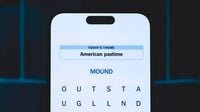Every morning, puzzle enthusiasts across the globe flock to their screens, eager for the latest challenge from The New York Times Games collection. While Wordle and Connections have dominated headlines and social media feeds for months, a new contender, Strands, is quietly capturing the hearts—and neurons—of word game lovers. On Tuesday, November 18, 2025, Strands delivered a puzzle that was as approachable as it was cleverly themed, offering a refreshing twist for both seasoned solvers and curious newcomers.
So, what exactly is Strands? According to Beebom, Strands is a word game that sits comfortably alongside NYT’s growing library of interactive puzzles. The game features a six-by-eight letter grid, and the objective is to weave together interconnected words that all relate to a daily theme. Unlike Wordle, where a single word must be guessed, or Connections, which asks players to sort words into categories, Strands demands a more holistic approach. Every letter in the grid is part of an answer, and words can snake across the board in any direction—up, down, left, right, or even diagonally, sometimes changing direction midstream. This dynamic grid ensures that each puzzle feels fresh and unpredictable.
The November 18 puzzle’s theme was announced as “All mixed up”—a playful nod to states of disorder, confusion, and chaos. Players were tasked with uncovering a set of words that all described things in disarray. For those struggling to make headway, the game provided a helpful hint: “Mixed together in a confused manner.” This clue, while broad, was a gentle nudge toward the types of words lurking in the grid.
But the real linchpin of every Strands puzzle is the Spangram—a special word or phrase that not only sums up the day’s theme but also stretches across the grid, either vertically, horizontally, or diagonally. For November 18, the Spangram was OUTOFORDER, running horizontally from left to right and starting with the letters “OU.” As The Economic Times noted, the Spangram acts as an anchor, helping solvers make sense of the remaining theme words. In this case, OUTOFORDER perfectly encapsulated the notion of things being “all mixed up.”
The full set of theme words for the day, as reported by multiple sources including Parade and Mashable, included JUMBLED, SCRAMBLED, CHUFFLED, CHAOTIC, SHUFFLED, and MUDDLED. Each word is a synonym for confusion or disorder, and together they painted a vivid picture of the day’s theme. The inclusion of CHUFFLED, a less common term, added a dash of linguistic spice—reminding players that Strands isn’t afraid to dig deep into the English lexicon.
For those unfamiliar with Strands’ mechanics, the rules are straightforward but demand careful attention. As outlined by Parade, players must drag or tap letters to form words, with each theme word remaining highlighted in blue once found. The board is designed so that no theme words overlap, and the entire grid must be filled to complete the puzzle. The Spangram, when correctly identified, highlights in yellow. If a player gets stuck, they can find non-theme words to earn hints—every three such words unlock a helpful clue, revealing the letters of a theme word or showing the correct letter order for an active hint.
One of the most intriguing aspects of Strands is its approach to difficulty. On November 18, the puzzle was widely regarded as accessible, with Beebom rating it just 1 out of 5 in terms of challenge—making it one of the easiest puzzles in recent memory. “The theme was direct, and the Spangram presented a recognizable phrase,” wrote a Beebom reviewer. Still, as The Economic Times pointed out, difficulty is inherently subjective; a puzzle that’s a breeze for one player might prove vexing for another, especially when it comes to recognizing synonyms or maneuvering through the grid’s twists and turns.
For players hunting for strategies, several tips emerged from the day’s coverage. Starting at the corners of the grid can be fruitful, as can thinking both literally and figuratively about the theme. Don’t be shy about using hints, especially if a single word could unlock the rest of the puzzle. And, of course, zeroing in on the Spangram early can split the board in half, guiding solvers toward the remaining answers.
Strands’ appeal is rooted not only in its clever wordplay but also in its sense of community. As Mashable observed, the game’s daily puzzles inspire lively discussion and friendly competition among fans. Players share hints, commiserate over tricky words, and celebrate their triumphs—sometimes even before their morning coffee. The game’s design ensures that every letter matters, and the variety of possible word paths keeps even the most experienced solvers on their toes.
For those who missed the November 18 puzzle, there’s no need to fret. NYT Strands now features an archive page, allowing subscribers to revisit past puzzles and hone their skills by selecting any desired date. Yesterday’s (November 17) puzzle, for example, had the answer WORKING DOGS—a stark thematic contrast to the chaos of “All mixed up.”
As Strands continues to grow in popularity, it’s carving out a unique niche in the NYT Games ecosystem. Its blend of word search, thematic depth, and daily novelty make it a must-play for anyone looking to stretch their vocabulary and pattern recognition skills. And with the promise of a new challenge every 24 hours, it’s no wonder that Strands is quickly becoming the next big thing in digital puzzles.
Whether you found OUTOFORDER in seconds or needed a few hints to get there, November 18’s Strands puzzle offered a reminder that sometimes, a little disorder can be a whole lot of fun.







